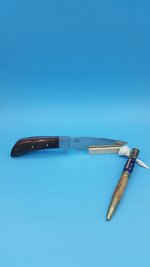Mullanphy
Member
I've been turning wood for a few years and decided to turn my hand to pens. Wooden pens I'm doing OK with, but most of my non-wood blanks (store bought acrylics and self-made epoxy resin) explode on the mandrel.
Sometimes I see
the adhesive separated from the brass tube
the adhesive separated from the blank
So many small gouges in the blank the cutter (standard HSS chisels and carbide tipped) just takes a big bite and spits it back at me
I've tried speeds from 800-2000 rpm
I've used both HSS chisels and the new-fangled carbide tools, or a combination of both
My tools are sharp
I used thick CA as well as 5 minute epoxy - I let every tube sit at least 24 hours so the adhesive will cure completely.
Tubes are sanded with 220 grit
Drilled holes in non-wood blanks are rinsed in water and let dry
Light, moderate, or heavy pressure seems to obtain the same results - another tube/blank good as a bad example.
What the heck am I doing wrong?
Sometimes I see
the adhesive separated from the brass tube
the adhesive separated from the blank
So many small gouges in the blank the cutter (standard HSS chisels and carbide tipped) just takes a big bite and spits it back at me
I've tried speeds from 800-2000 rpm
I've used both HSS chisels and the new-fangled carbide tools, or a combination of both
My tools are sharp
I used thick CA as well as 5 minute epoxy - I let every tube sit at least 24 hours so the adhesive will cure completely.
Tubes are sanded with 220 grit
Drilled holes in non-wood blanks are rinsed in water and let dry
Light, moderate, or heavy pressure seems to obtain the same results - another tube/blank good as a bad example.
What the heck am I doing wrong?

